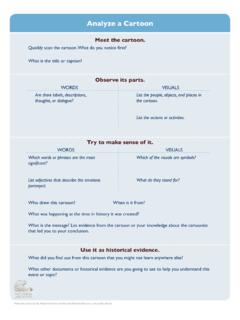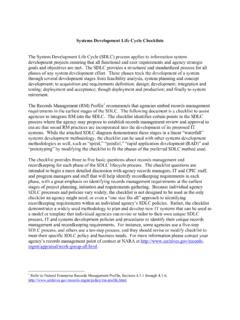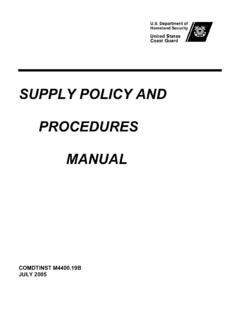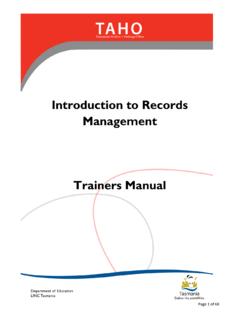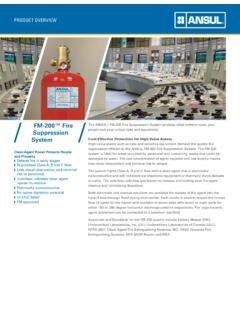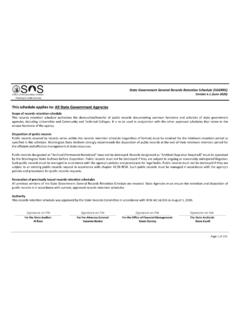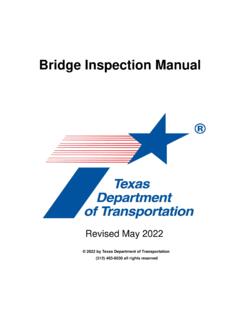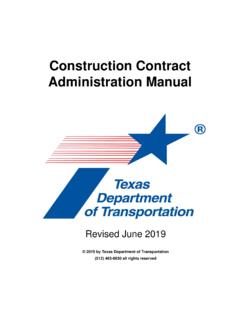Transcription of Disposition of Federal Records: A ... - National Archives
1 Disposition of Federal Records: A Records Management Handbook 2000 Web Edition (of 1997 printed publication) Table of Contents Message from the Archivist FOREWORD I. A MANAGEMENT OVERVIEW o Introduction o Nature of the Records Disposition Program o The Program Directive and Its Contents o Program Promotion o Program Evaluation o Conclusion II. RECORDS IDENTIFICATION AND SCHEDULING: AN OVERVIEW o Introduction o Records, Nonrecord Materials, and Personal Papers o Records Disposition Functions o Basic Steps in Scheduling Records o Conclusion III. THE RECORDS INVENTORY o Introduction o Review of Agency Functions and Recordkeeping Requirements and Practices o Inventorying: What, Why, and How o Inventorying: Scope, Focus, and Responsibility o The Series Inventory o The Information System Inventory o Verification 1 o Conclusion IV. RECORD VALUES AND SCHEDULE INSTRUCTION o Introduction o Evaluating Records: The Agency's Viewpoint o Evaluating Records: NARA's Viewpoint o Preparing Disposition Instructions o Understanding General Records Schedules o Applying General Records Schedules to Agency Records o Conclusion V.
2 SCHEDULE PREPARATION AND CLEARANCE o Introduction o Completing an SF 115 o Description and Added Information o Electronic, Audiovisual, and Other Special Records o Other Considerations in Completing an SF 115 o Arranging a Records Schedule o Assembling a Draft Records Schedule o Obtaining Internal Clearances and GAO's Approval o Submitting an SF 115 for NARA's Approval o Conclusion VI. SCHEDULE IMPLEMENTATION o Introduction o Issuing the Schedule o Training Employees o Applying the Schedule to Permanent Records o Applying the Schedule to Temporary Records o Reviewing and Updating the Schedule o Related Disposition Matters o Conclusion VII. PROGRAM EVALUATION 2 o Introduction o Reports on the Program o Self-Evaluation Guidelines o NARA's Evaluation of Agency Programs o Conclusion APPENDIX A. RECORDS Disposition STATUTES o 44 Chapter 21 o 44 Chapter 29 o 44 Chapter 31 o 44 Chapter 33 o 18 Chapter 101 APPENDIX B.
3 RECORDS Disposition REGULATIONS (36 CFR 1228) o Subpart A: Records Disposition Programs o Subpart B: Scheduling Records o Subpart C: General Records Schedules o Subpart D: Implementing Schedules o Subpart E: Loan of Permanent and Unscheduled Records o Subpart F: Emergency Authorization to Destroy Records o Subpart G: Damage to, Alienation, and Unauthorized Destruction of Records o Subpart H: Transfer of Records from the Custody of One Executive Agency to Another o Subpart I: Transfer of Records to Records Storage Facilities o Subpart J: Transfer, Use, and Disposition of Records in a NARA Records Center o Subpart K: Facility Standards for Records Storage Facilities o Subpart L: Transfer of Records to the National Archives of the United States o Appendix A to Part 1228 - Minimum Security Standards for Level III Federal Facilities 3 o Appendix B to Part 1228 - Alternative Certified Fire-safety Detection and Suppression System(s) Authority: 44 chs.
4 21, 29, and 33. APPENDIX C. APPRAISAL GUIDELINES FOR PERMANENT RECORDS APPENDIX D. RECORDS MANAGEMENT PUBLICATIONS APPENDIX E. LIST OF REGIONAL RECORDS SERVICES FACILITIES From the Archivist This web-formatted version of the 1997 reprint of the Disposition of Federal Records handbook has been changed only to update organizational information and reflect changes in regulations. As indicated in the National Archives and Records Administration's Strategic Plan, Ready Access to Essential Evidence, we are reviewing our records management policies. This handbook and other records management issuances will be more extensively revised in the future for conformance to changes in policy and in recordkeeping practices affected by technological developments. Please let me know if you have suggestions for improving this handbook or any of our other records management publications. JOHN W. CARLIN Archivist of the United States FOREWORD An effective records Disposition program is the key to successful records management in Federal agencies.
5 It helps ensure that agencies have the recorded information necessary to conduct Government business, avoid waste, and preserve America's documentary heritage. This handbook explains how to establish, manage, and operate a records Disposition program within a Federal agency. It emphasizes the necessity of each agency's developing, implementing, and updating a records schedule for all agency records, 4 regardless of media or location. Developing a records schedule includes reviewing agency functions and recordkeeping requirements, inventorying and evaluating records, preparing Disposition instructions, organizing and clearing the schedule internally, and obtaining approval from the National Archives and Records Administration (NARA) and, if necessary, from the General Accounting Office (GAO). Proper implementation involves issuing the approved records schedule as an agency directive, training employees to use it, and carefully applying the schedule's provisions to both permanent and temporary records.
6 The schedule's final objective is to ensure the authorized, appropriate, and timely Disposition of the agency's records. Besides being developed and implemented, the schedule needs to be reviewed at least annually and updated whenever necessary. The handbook explains how to evaluate a records Disposition program in order to make improvements. It also describes NARA's role in helping agencies comply with laws and regulations regarding records Disposition and other aspects of records management. The appendixes contain relevant laws and regulations, appraisal guidelines for permanent records, a listing and description of NARA's records management publications, and a list of regional records facilities. The frequent repetitions, summaries, and cross-references are intended to facilitate use of this edition for instructional purposes as well as for self-study. This handbook does not cover the Disposition of Presidential records or records of the Congress.
7 Richard A. Wire wrote this revised edition of Disposition of Federal Records. He wishes to thank Frank B. Evans, William H. Leary, and Katherine V. Coram for their advice and assistance. This publication was designed and illustrated by John H. Hedges. Bibliographic note: The 2000 web edition is based on the 1997 printed publication Disposition of Federal Records, a Records Management Handbook, Second Edition, National Archives and Records Administration, Office of Records Services -- Washington, (1997). The web edition may vary from the printed version. The text has been changed to update organizational information and reflect changes in regulations. 5 I. A Management Overview Introduction Nature of the Records Disposition Program The Program Directive and Its Contents Program Promotion Program Evaluation Conclusion I. A Management Overview An effective records Disposition program is essential to successful records management, which is an integral part of information resources management.
8 A Disposition program requires a strong directive. managing the records Disposition program includes training employees, publicizing the program, and cultivating professional relationships. Agency records officers should participate in the development of electronic and other recordkeeping systems to ensure proper planning for Disposition . Agency records officers need to evaluate their records Disposition programs periodically. Introduction This chapter describes how to establish and manage a records Disposition program, while the following chapters explain how to implement it. An effective records Disposition program is the key to successful records management, which, in turn, ensures that Government activities are documented properly, efficiently, and economically. managing Federal records requires an understanding of their essential role in administering Government affairs and of the relationship of records management to other information resources management programs.
9 It also entails a knowledge of recordkeeping requirements. managing the Disposition program is based on a directive establishing the program and involves an understanding of the program's nature, of promotion methods, and of evaluation techniques. Records and Information Resources Management 6 managing recorded information is an important responsibility of every Federal agency. As the basic administrative tool by which the Government does its work, records are a basic component of each agency's information resources. Like other resources, they must be managed properly for the agency to function effectively and comply with Federal laws and regulations. According to Federal law (44 2901), records management means: the managerial activities involved with respect to records creation, records maintenance and use, and records Disposition in order to achieve adequate and proper documentation of the policies and transactions of the Federal Government and effective and economical management of agency operations.
10 Along with data processing and telecommunications, records management is an integral part of information resources management (IRM). (See fig. 1-1.) IRM is concerned with the creation, maintenance and use, and Disposition of information as well as with related resources, or assets, such as personnel, equipment, funds, and technology. In accordance with 44 3504, the Office of Management and Budget (OMB) works with the National Archives and Records Administration (NARA) and the General Services Administration (GSA) to promote the coordination of Federal information policy, including records management. (For more details on OMB's role in IRM, see OMB Circular No. A-130, Management of Federal Information Resources.) 7 Records Management Processiing Telecommunications. Flguire 1-1. IRM Components In setting forth records management responsibilities, Federal law requires each agency head to make and preserve records containing adequate and proper documentation of the organization, functions, policies, decisions, procedures , and essential transactions of the agency and designed to furnish the information necessary to protect the legal and financial rights of the Government and of persons directly affected by the agency's activities [44 3101].


